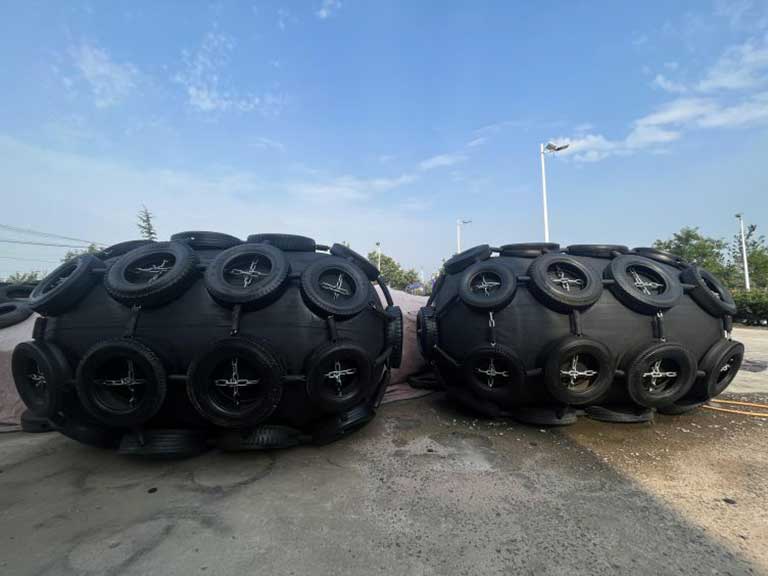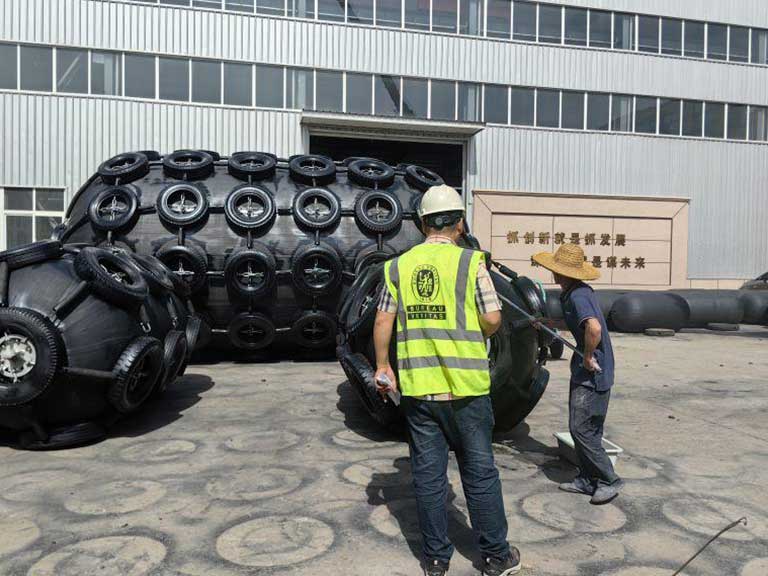船舶の入渠時および船舶間の積み替え作業中の安全確保は、海運業界にとって最優先事項です。安全とセキュリティ確保の重要な側面の一つとして、横浜防舷材などの海洋機器の適切な使用が挙げられます。そのため、船体内の空気圧を適正に保つことが重要です。 フェンダー空気圧これは、性能と寿命に影響を与えるだけでなく、船舶とマリーナの保護にも直接影響を与えるためです。
では、空気圧式フェンダーにとって理想的な空気圧とは一体何でしょうか?理想的な空気圧を維持するにはどうすればよいでしょうか?この記事では、空気圧式フェンダーにおける適切な空気圧の重要性について解説します。
目次
空気圧フェンダーとその重要性を理解する
まず、 空気圧フェンダーとは何かこれらは膨張式の船舶保護装置です。船舶がドックや他の船舶に接触した際に、衝撃エネルギーを吸収する重要な役割を果たします。
これらの空気圧式防舷材は、圧縮空気を利用してクッション効果を生み出し、衝撃力を表面全体に分散させます。最終的には、船舶と港湾施設の両方を保護する役割を果たします。そのため、高品質の空気圧式防舷材は海事産業にとって非常に重要です。
空気圧フェンダーの性能における適切な圧力の重要な役割
インフレータブルフェンダーの性能は、その内部圧力に直接関係しています。初期圧力は、空気圧フェンダーが衝撃エネルギーを効果的に吸収することを保証します。さらに、船舶がドッキングした際に、一貫した反力を提供します。したがって、適切な圧力は最適なエネルギー吸収を確保します。同時に、圧縮および復元時にフェンダーの構造的完全性を維持します。
ヘンガー氏は、ヨコハマのフェンダーを、ある程度の圧縮力を保ちつつ、硬くなるまで空気を入れることを推奨しています。空気を入れすぎるとフェンダーが硬くなりすぎて衝撃吸収力が低下する可能性があります。一方、空気圧が不足すると、空気圧式フェンダーの反力が弱まります。

理想的な空気圧フェンダーの圧力
空気圧式フェンダーの有効性は、その内部圧力に大きく依存します。フェンダーが最適な性能を発揮し、船舶に必要な保護を提供するには、適切な圧力管理が不可欠です。
標準圧力範囲
空気式防舷材の一般的な内圧範囲は、通常50kPa~80kPaに設定されています。この範囲であれば、さまざまな環境条件下で安定した性能を発揮し、船舶とドックへのダメージを最小限に抑えながら、接岸時の衝撃力を効果的に吸収することができます。
空気式防舷材のサイズや種類が異なると、使用中に内圧の調整が必要になることがあります。例えば、大型の防舷材は一般に構造強度やエネルギー吸収能力を維持するために高い圧力を必要とするが、小型の防舷材は低い圧力でも十分に機能することがある。さらに、港の接岸や船から船への移動など、防舷材の特定の用途がその圧力要件に影響することもある。
ISO 17357のような国際規格は、製造および使用中の空気式防舷材の圧力範囲と性能に関する明確なガイドラインを定めています。これらの規格を遵守することで、世界中のフェンダー・アプリケーションにおいて一貫した高い品質と信頼性が保証され、不適切な圧力設定によって引き起こされる潜在的なリスクが軽減されます。
このため、当社は、インフレータブルフェンダーの圧力範囲をよりよく理解していただくために、空気圧フェンダーの仕様書を作成しました。
| サイズ | 使用圧力 | 圧縮変形率 60% | 安全な圧力 | 試験圧力 | 体重 | |||||||
| D×L | 50タイプ | 80タイプ | 50タイプ | 80タイプ | 50タイプ | 80タイプ | 50タイプ | 80タイプ | 50タイプ | 80タイプ | ||
| mm×mm | KPa | カウンターフォース(KN) | エネルギー吸収(KJ) | カウンターフォース(KN) | エネルギー吸収(KJ) | KPa | KPa | キロ | ||||
| 500×1000 | 50 | 80 | 64 | 6 | 85 | 8 | - | - | 200 | 250 | 36 | 40 |
| 600×1000 | 50 | 80 | 74 | 8 | 98 | 11 | - | - | 200 | 250 | 42 | 47 |
| 700×1500 | 50 | 80 | 137 | 17 | 180 | 24 | - | - | 200 | 250 | 70 | 79 |
| 1000×1500 | 50 | 80 | 182 | 32 | 239 | 45 | - | - | 200 | 250 | 114 | 127 |
| 1000×2000 | 50 | 80 | 257 | 45 | 338 | 63 | - | - | 200 | 250 | 158 | 175 |
| 1200×2000 | 50 | 80 | 297 | 63 | 390 | 88 | - | - | 200 | 250 | 198 | 218 |
| 1350×2500 | 50 | 80 | 427 | 102 | 561 | 142 | - | - | 200 | 250 | 286 | 314 |
| 1500×3000 | 50 | 80 | 579 | 153 | 761 | 214 | - | - | 200 | 250 | 366 | 403 |
| 1700×3000 | 50 | 80 | 639 | 191 | 840 | 267 | - | - | 200 | 250 | 470 | 512 |
| 2000×3500 | 50 | 80 | 875 | 308 | 1150 | 430 | - | - | 200 | 250 | 612 | 670 |
| 2500×4000 | 50 | 80 | 1381 | 663 | 1815 | 925 | 175 | 230 | 250 | 300 | 1190 | 1273 |
| 2500×5500 | 50 | 80 | 2019 | 943 | 2653 | 1317 | 175 | 230 | 250 | 300 | 1400 | 1514 |
| 3300×4500 | 50 | 80 | 1884 | 1175 | 2476 | 1640 | 175 | 230 | 250 | 300 | 1844 | 1967 |
| 3300×6500 | 50 | 80 | 3015 | 1814 | 3961 | 2532 | 175 | 230 | 250 | 300 | 2340 | 2518 |
| 3300×10600 | 50 | 80 | 5257 | 3067 | 6907 | 4281 | 175 | 230 | 250 | 300 | 3800 | 4090 |
| 4500×9000 | 50 | 80 | 5747 | 4752 | 7551 | 6633 | 175 | 230 | 250 | 300 | 4980 | 5316 |
| 4500×12000 | 50 | 80 | 7984 | 6473 | 10490 | 9037 | 175 | 230 | 250 | 300 | 6060 | 6508 |

最適な圧力要件に影響を与える要因
空気圧式防舷材の最適な圧力には、防舷材のサイズ、船舶のサイズと重量、環境条件、運用要因、温度変化など、いくつかの要因が影響します。例えば、大型の防舷材は容積と表面積が大きいため、より正確な圧力管理が必要です。また、船舶の重量が大きくなると防舷材にかかる力も大きくなるため、圧力レベルの調整が必要になります。波高や風力などの環境条件も、必要な圧力に影響を与えます。
- フェンダーのサイズは、容積と表面積の違いにより、圧力要件に直接影響します。
- 船のサイズと重量は、フェンダーに及ぼされる力を決定するため重要です。
- 最適な圧力設定のためには、温度変化などの環境要因と動作要因を考慮する必要があります。
空気圧フェンダーを適切に膨らませるためのステップバイステップガイド
空気圧フェンダーの有効性は、その膨張の正確さに大きく依存します。 適切な空気圧により、フェンダーは最高のパフォーマンスを発揮しますこれにより、フェンダーは船舶の入港および係留作業中に必要な保護を提供できるようになります。
インフレに必要な設備空気圧式フェンダーを正しく膨らませるには、専用の器具が必要です。フェンダーのサイズに応じて、手動式、足踏み式、電動式など、適切なエアポンプが必要です。空気圧を正確に測定するには、圧力計も不可欠です。さらに、フェンダーバルブに適合するバルブアダプターとノズルアタッチメントも必要です。これにより、良好な密閉性が確保され、空気漏れを防ぎます。
膨張前の準備:空気を入れる前に、フェンダーに損傷がないか点検してください。バルブが清潔で機能していることを確認してください。フェンダーは、あらゆる方向から簡単にアクセスできる安定した場所に設置してください。この準備は、安全かつ効率的に空気を入れるために不可欠です。
インフレのプロセスまず、バルブカバーを回して外します。このカバーにはチェックバルブが内蔵されており、フェンダーが膨らんだ際に空気が漏れるのを防ぎます。ポンプをバルブに接続し、ノズルがしっかりと密閉されていることを確認してください。フェンダーを徐々に膨らませ、定期的にゲージまたは指で圧力を確認してください。フェンダーの内部構造を損傷する可能性があるため、空気を入れすぎないようにしてください。希望の圧力に達したら、すぐにポンプを外し、バルブを固定してください。

不十分な圧力または過剰な圧力のリスク
低インフレの影響
空気圧式防舷材の内部圧力が不十分な場合、船舶の接岸時の衝撃力を吸収する能力が大幅に低下します。つまり、防舷材が重要な瞬間に十分な緩衝効果を発揮できない可能性があります。その結果、船舶とドック、あるいは他の船舶が直接衝突し、損傷のリスクが高まります。
さらに、低圧に長時間さらされると、フェンダーの構造が変形し、保護性能がさらに低下する可能性があります。そのため、フェンダー圧力が推奨範囲内に維持されていることを確認するための定期的な点検は、船舶と港湾施設の両方を保護するために不可欠です。
過剰インフレの影響
内部圧力が過剰になると、フェンダー材に過度の引張応力が生じる可能性があります。空気圧式フェンダーはある程度の弾性を備えていますが、過度の圧力がかかるとゴム材が過度に伸び、フェンダーが破裂するリスクが高まります。
これはフェンダーの故障につながるだけでなく、高額な修理や交換が必要になる可能性があります。このような事態を避けるため、空気を入れる際はメーカーの圧力基準を厳守することをお勧めします。さらに、安全範囲を超えないように定期的に圧力をチェックする必要があります。
空気圧フェンダーの適切な圧力をチェックし維持する方法
空気圧式フェンダーの有効性を保証するには、圧力の確認と維持方法を理解することが不可欠です。適切に膨らませたフェンダーは、船舶の安全と保護にとって不可欠です。
目視および手動圧力テスト方法
空気圧式フェンダーの空気圧チェックには、目視検査と手動テストの両方が必要です。最初のステップは目視検査で、たるみや非対称形状などの空気圧不足の兆候がないか確認します。さらに、指で押し込むテストも実用的な手動テストです。適切に空気圧調整されたフェンダーは、しっかりとした抵抗感がありながら、指で約2cm押し込むことができるはずです。
- 目に見える空気圧不足の兆候を探します。
- 指テストを使用して硬さを測定します。
- 重要なアプリケーションでは専門的な圧力テストを検討してください。

圧力維持スケジュールとベストプラクティス
定期的な空気圧メンテナンススケジュールを確立することが重要です。点検頻度はフェンダーの使用状況によって異なります。頻繁に使用するフェンダーは、より頻繁な点検が必要です。気温変動などの環境要因も空気圧に影響を与えるため、調整が必要になります。
| 使用頻度 | 推奨点検間隔 |
| 重い | 週刊 |
| 中程度 | 毎月 |
| 時々 | 使用前に |
ベストプラクティスとしては、すべての圧力チェックと調整を文書化し、予備の膨張装置を保管し、バルブを腐食から保護することなどが挙げられます。
結論
適切な圧力を維持することは、フェンダーの安全性と耐用年数にとって非常に重要です。Henger Shipping Suppliesでは、適切な圧力管理を重視しています。これにより、空気圧式フェンダーの効率的な性能を確保し、耐用年数を延ばすことができます。
空気圧式フェンダーの圧力を定期的に点検し、維持することで、停泊中や航海中の船舶の安全を確保できます。適切な空気圧を保つことで、船舶とドックを保護し、潜在的な損傷を最小限に抑えることができます。
ご質問やご不明な点がございましたら、お気軽にお問い合わせください。当社の技術チームがいつでもサポートを提供し、お客様の機器の安全性とパフォーマンスを確保いたします。

よくあるご質問
空気圧フェンダーに推奨される空気圧はどれくらいですか?
推奨空気圧はフェンダーのサイズと種類によって異なります。最適な性能と耐久性を確保するため、メーカーのガイドライン(通常は50~100 kPa)に従うことをお勧めします。
空気圧フェンダーの空気圧はどのくらいの頻度でチェックする必要がありますか?
定期的な点検は非常に重要です。推奨レベルを維持し、損傷を防ぐために、少なくとも週に1回、使用前後に圧力を点検することをお勧めします。
空気圧フェンダーの最適な圧力要件に影響を与える要因は何ですか?
フェンダーのサイズ、材質、運転条件(例:温度、接岸速度)などの要因が理想的な圧力に影響を与えます。当社はこれらの要因を考慮して、お客様のフェンダーに最適な圧力を決定します。
標準のエアポンプを使用して空気圧フェンダーを膨らませることはできますか?
標準的な空気ポンプも使用できますが、正確な空気入れを実現し、過圧や低圧を避けるために、高品質の精密ポンプまたは圧力計付きのコンプレッサーを使用することをお勧めします。
空気圧フェンダーが適切に膨らんでいるかどうかはどうすればわかりますか?
適切に空気を入れられたフェンダーは、表面が硬く、それでいてしなやかでなければなりません。圧力計を使って圧力を確認することもできます。目視による点検と定期的な空気圧チェックを組み合わせることをお勧めします。
空気圧フェンダーの空気圧が低すぎたり高すぎたりすると、どのような結果になりますか?
空気圧不足はフェンダーの性能低下、損傷リスクの増大、安全性の低下につながる可能性があります。空気圧が高すぎるとフェンダー素材に過度の負担がかかり、破損につながる可能性があります。推奨空気圧を維持することの重要性を改めて強調いたします。
極端な気象条件でも空気圧フェンダーを使用できますか?
空気圧フェンダーはさまざまな厳しい気象条件に対応できますただし、極端な気温や気象条件によっては性能が影響を受ける可能性があります。安全かつ効果的にご使用いただくために、メーカーのガイドラインを参照し、必要な予防措置を講じることをお勧めします。




